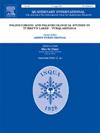拉科罗纳的尼斯塔姆化:陶瓷器的微植物学分析表明玛雅古典晚期的烹饪技术
IF 1.8
3区 地球科学
Q3 GEOGRAPHY, PHYSICAL
引用次数: 0
摘要
玉米(Zea mays)是玛雅古典时期(约公元 250-900 年)和其他中美洲社会饮食的基本组成部分。将玉米在碱性溶液中煮熟的过程(Nixtamalization)非常重要,因为它可以提高玉米的营养价值。然而,在考古记录中记录这一过程并不简单。对从低地玛雅遗址 La Corona(危地马拉佩滕)晚期古典时期(约公元 600-900 年)的陶瓷器和磨石中收集的残留物进行的微生物学研究发现了淀粉球状物的存在。偏光显微镜和扫描电子显微镜(SEM)成像结合碘染色证实了它们的真实性。我们认为,在公元 7 世纪和 8 世纪期间,拉科罗纳曾出现过作为烹饪技术的尼斯塔姆化。我们展示了来自祭祀背景的证据,特别是墓葬和宴席/祭祀活动。这是玛雅地区直接从与准备和/或食用食物有关的陶瓷器皿中发现的石灰处理玉米的最早证据。本文章由计算机程序翻译,如有差异,请以英文原文为准。
Nixtamalization at La Corona: Microbotanical analysis of ceramic vessels indicates Late Classic Maya cooking techniques
Maize (Zea mays) was a fundamental part of the diet for the Classic period Maya (ca. 250–900 CE) and other Mesoamerican societies. Nixtamalization, the process whereby maize is cooked in an alkaline solution, is important as it enhances the nutritional value of maize, among other reasons. However, documenting this process in the archaeological record is not straightforward. A microbotanical study of residues collected from ceramic vessels and grinding stones from Late Classic (ca. 600–900 CE) contexts at the Lowland Maya site of La Corona (Peten, Guatemala), revealed the presence of starch spherulites. Their authenticity was confirmed by polarized microscopy and Scanning Electron Microscope (SEM) imaging combined with iodine staining. We argue that nixtamalization as a cooking technique was occurring at La Corona during the 7th and 8th centuries CE. We present evidence from ceremonial contexts, specifically burial and feasting/commensal events. This is the earliest evidence of lime-treated maize in the Maya area recovered directly from ceramic vessels linked to preparation and/or consumption of food.
求助全文
通过发布文献求助,成功后即可免费获取论文全文。
去求助
来源期刊

Quaternary International
地学-地球科学综合
CiteScore
5.60
自引率
4.50%
发文量
336
审稿时长
3 months
期刊介绍:
Quaternary International is the official journal of the International Union for Quaternary Research. The objectives are to publish a high quality scientific journal under the auspices of the premier Quaternary association that reflects the interdisciplinary nature of INQUA and records recent advances in Quaternary science that appeal to a wide audience.
This series will encompass all the full spectrum of the physical and natural sciences that are commonly employed in solving Quaternary problems. The policy is to publish peer refereed collected research papers from symposia, workshops and meetings sponsored by INQUA. In addition, other organizations may request publication of their collected works pertaining to the Quaternary.
 求助内容:
求助内容: 应助结果提醒方式:
应助结果提醒方式:


